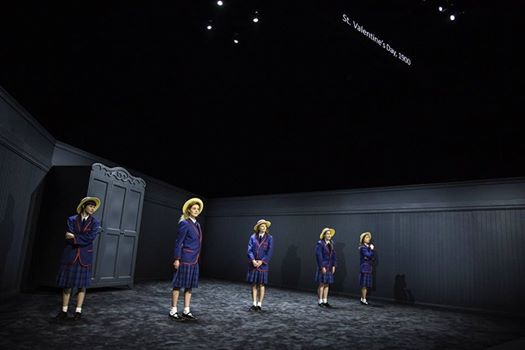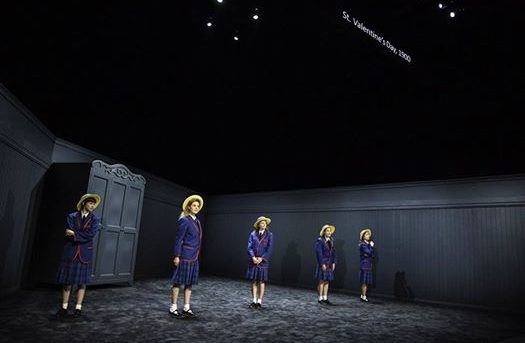Malthouse: Picnic at Hanging Rock
“Everything begins and ends at exactly the right time.” – Joan Lindsay, Picnic at Hanging Rock
Five women appear on stage, dressed in the uniforms of private school girls we might encounter in the street or on a train. There is a tension in that familiarity; we have seen these girls before and are about to see them vanish.

These young women tell us the story of the disappearance of three schoolgirls on Valentine’s Day in 1900. They tell a story they have heard before and a story we have heard before. It is a local legend, a myth of the Victorian bush.
Tom Wright and Matthew Lutton’s stage adaptation of Picnic at Hanging Rock, based on the novel by Joan Lindsay, knows that this is another iteration of campfire storytelling. It expects that we have heard the tale, whether we read the book in school or watched the film or simply heard tell of the disappearance of schoolgirls at the turn of last century.
In an era when we are inundated with reboots and re-imaginings, remakes and re-iterations, it’s comforting to watch a piece that – at its core – reverberates with every time we’ve heard this story. And it recounts the tale in the way we might tell it: in chunks, in chapters, in highlights and in frights.
The stage is a grey carpeted floor, grey painted walls and a cupboard that evokes 1900. It also evokes a famous literary wardrobe and alludes to another world where we might vanish. (Interestingly, not only does it embrace Lindsay’s original novel, it also knows about the “missing” Chapter 18, published three years after Lindsay’s death.)
The set is stark, but the bright blue of the uniforms pop. As the story progresses, this stark set becomes the schoolhouse, the schoolyard, the bush, the police station and on and on. Inside the Merlyn Theatre, our imagination grows, as these girls are drawn deeper and deeper into the mystery of Hanging Rock.
This is Lutton’s first show as director in his debut season as Artistic Director of Malthouse Theatre. Choosing such a well-known text (that was turned into an even more famous film in 1973) to translate to the stage is a fraught endeavour. We all bring our responses to the book and to the film. We all sit there in anticipation. What will the playwright and director evoke in our memories of Lindsay’s novel and Peter Weir’s motion picture?
This production was haunting, much like the book and the film. But it is also creepy and, in some moments, genuinely terrifying. Sound designer J David Franzke’s subtle use of bush noises – some recorded around Hanging Rock itself – is just enough to make us feel like we are there. Composer Ash Gibson Greig’s music puts things off-kilter and the audience on edge.
But it’s a combination of Franzke, Greig and Paul Jackson’s lighting that really throws the audience into the black void; we watch these five women appear and disappear over and over again. One moment the stage is empty, the next, there’s one girl, then another, and then the twisted, broken body of a third.
Assembled on stage is a cast of high talent that each have their moments to shine. In need of particular praise is Elizabeth Nabben, who brings to life a difficult character in Mrs Appleyard – a headmistress who wants to tame the girls of her school, much like Australian pioneers wanted to tame the wild bush. Also impressive is Arielle Grey, who plays Edith and Sara, a study in contrasts, if ever there was one. Grey has several comic moments that are upended by dramatic scenes later in both Edith and Sara’s stories. She is superb.
As the play progresses, the actors become the girls playing other people. And slowly the uniforms are replaced by the dresses and skirts we are expecting, and the suits of the men in the town – who watch the girls and then search for them. Piece by piece, scene by scene, we are taken away from the familiar present and plunged a century into the past.
Picnic at Hanging Rock is Australian gothic, no doubt. A story of adolescence pitched against the unforgiving terrain of the outback. It’s more than just the story of girls disappearing on a picnic, though. It’s about the consequence and echoes of that story through the school and through Mount Macedon. Through the early 1900s up to the 60s and 70s, when the story – whether fact or fiction – was first recounted.
Wright and Lutton’s Picnic at Hanging Rock hears those echoes continue through to the present day and retells a story we think we’re familiar with in a surprising, delightful and terrifying way. Everything begins and ends at the right time, so be sure not to be late to this particular and peculiar picnic.




